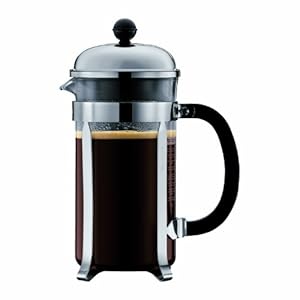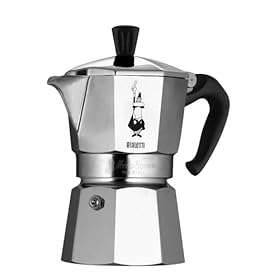There are some things all people need. When it comes to coffee, certain products must be in your possession to avoid failure. You can’t just go to Starbucks everyday and be satisfied with wasting your money on something you could make even better yourself. Yes, often the coffee you make at home is terrible, but there’s hope. With these products you will permanently upgrade your coffee life and transcend into coffee Heaven.
Aeropress

I don’t think anyone would look at this product and think for a split second that it was worth the plastic it is made with. Looks are deceiving, as this little plastic “invention” makes a cup of coffee better than 99% of coffee makers.
The best part is how quick it is: you pour hot water (175°), stir for 10 seconds, and press directly into your favorite mug. In less than a minute, you can hit the road with an excellent cup of coffee. It’s also the perfect coffee maker for travel, very compact and rinsed clean in seconds.
The Aeropress uses the ancient technology of increased pressure to extract flavor out of the coffee quickly. When you press down the plunger, you increase air pressure in the cylinder, driving the brew through the grounds and into your cup. A paper filter is utilized, leaving you with a clean cup, free of sediment. You can get away with a variety of grind consistencies, but for best results, try something just short of espresso.
A major downfall is that you are limited to 8 ounces of coffee per press, and although it is quick to make several batches, it is a hassle that I would never choose to suffer through if I had another option…
French Press

One look at this contraption and, by contrast, you know you are dealing with one elegant and refined piece of coffee equipment. The pressing action here moves a wire mesh filter through the brew, packing the coffee grounds in the bottom of the “pitcher” and allowing a perfect pour into your cup of choice.
I’ve read several places to use relatively coarsely ground coffee for french press, but your coffee should not resemble gravel. I prefer a minimally coarse grind, if you could even call it that. You’ll need a burr grinder in any case, more on that later.
Brew time is 3 to 4 minutes, though I’ve tried as little as 2 minutes with good results. You can let it sit in there for 10 minutes and get even more caffeine extraction.
Allow boiled water to cool for about 30 seconds, and you should be at around 200° F when you pour it in. Be sure to completely soak and agitate the grinds as you pour in the water, and stir or swirl once again a couple minutes into the brew. This assures all the water in the pitcher gets a fair chance to turn into coffee.
French press coffee has an enhanced mouth-feel because the coffee oils don’t get soaked up in a paper filter. The fine grit that remains adds another layer to the coffee’s complexity and character. A French press extracts every bit of taste out of the bean in the most natural way possible; you will never believe it when you taste it for the first time.
Get a nice Bodum 8-cup model to get started some morning in the near future. You’ll be glad you have the extra capacity when brewing for friends, and it handles making an 8 ounce cup just as well.
Stove-top Espresso Maker

Popular in other parts of the world, these things have remained inexplicably unknown to most Americans. They make a strong, rich coffee that is similar to espresso. They come in various sizes and styles, and you can find one that fits your unique personality if desired. For an inexpensive, no-nonsense version, just pick up a Bialetti Moka Pot. Be aware, the “cups” they refer to are 2 ounces each. Use this handy table for reference, because it’s hard to multiply by 2 in your head:
| Size | Actual Volume |
|---|---|
| 3-cup | 6 ounces |
| 6-cup | 12 ounces |
| 9-cup | 18 ounces |
| 12-cup | 24 ounces |
Brewing time is under 4 minutes. A fine espresso grind is recommended for most stove-top espresso makers. After a few minutes on medium heat, the coffee slowly spills into the upper reservior, ready for pouring. Moka Pots are well-suited to electric and gas ranges, propane burners, and campfires.
To make espresso like a true barista, all you need is a Bialetti Brikka. The Brikka is a variation of the Moka Pot with an extra pressure valve. The high pressure enhances the flavor extraction process, just like a real espresso machine. Real froth or “crema” is made as the coffee foams out from under the valve into the upper reservoir. The Brikka holds its own with espresso machines costing thousands of dollars.

While it is by no means challenging to use a Brikka, you do have to exert some care with several steps. The grind should be slightly coarser than true espresso, and the grinds should sit light and fluffy in the metal filter. If you pack it or pat it down, water won’t move through too well and you can get “dud” brews. After placing on high heat, you have to stay vigilant waiting for the Brikka to “explode”. At times my Brikka needs a little encouragement in the form of a light tap on the pressure weight, and frothy oozing yumminess ensues.
When frothing turns into sputtering steam, pour immediately into espresso cups to maximize froth preservation. With a maximum 4 ounce brewing capacity, you won’t be sippin’ long with this badboy unless you add a ton of milk. It’s a superior coffee while it lasts, but I prefer the Moka Pot simply because you can make more coffee with it, prolonging your enjoyment.
A Brief Coffee Primer
To assure excellent coffee with any of the coffee making gadgets described in this article, you need to start with fresh, quality coffee. You can use any device you want to brew coffee with old, ground coffee beans, but it will never taste good.
Where can you get fresh roasted coffee? Try local coffee shops and online stores that ship only fresh roasted coffee. If you buy at your local grocery store, try to get something you know has a high turnover, with a higher chance of being somewhat fresh. If you at least start with whole beans and grind at home, you are being more savvy than 99% of coffee drinkers who buy pre-ground coffee, and that’s something to be very proud of.
Roasted coffee loses much of its flavor after just a couple weeks. For this reason, freezing your beans is appropriate unless you are storing for less than two weeks. It is best to avoid coffee freezing, but a month of freezing is undeniably less harmful to bean integrity than a month of rotting at room temperature.
Flavor also degrades rapidly after coffee is ground, so grinding should be done just before brewing. But don’t use a crappy grinder with a french press. Generally this means a whirly blade, which gives you almost no control, inevitably producing heaps of unfortunate coffee “dust”. The result with a french press is a unevenly brewed coffee, due to the uneven grind, and gritty bitterness caused by the talc-like coffee dust that flows through the mesh filter into your mug. You can actually get by with a whirly blade using a drip coffee maker, because of the paper filter.
A decent burr grinder
at home ensures a consistent grind and lets you preserve the freshness of whole beans. You can spend a lot of money on a nice burr grinder, and I would encourage you to do so. If you don’t want to invest in a burr grinder, consider using the nice commercial grinder where you buy your coffee, dialed in for the type coffee you are making. Freshness will decline exponentially after grinding, but at least the coffee will brew properly.
Conclusion
At this time, it is appropriate to click on the picture of the coffee maker above that most intrigued you, and you will be magically transported to Amazon.com to make a purchase you will never regret. Then, with a bit of rage, go and snatch up your bulky electric drip machine and find some final resting place for it. Just don’t give it to anyone you like.

